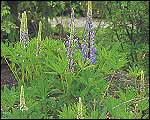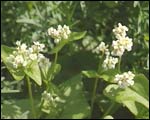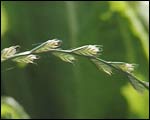Cover cropsRuud Kleinpaste shows us how to improve our soil quality by planting cover crops. By planting a cover crop, you are giving your soil a break. You get more organic material into the soil and you look after its fertility — the nitrogen, the phosphates and the potassium. More importantly, cover crops are short term — two to three months — and they come in various mixtures. The most important point is that none of the plants in your cover crop should be an invasive weed. I'm going to have a go at sowing a cover crop here, but the problem is what to sow. To help me with that is Richard Maine, my colleague from UNITEC, who has sections of cover crops growing.
That means they can fix their own nitrogen from the air, and the reason they can do it is because, if you dig up a lupin plant or a clover plant, you will see, scattered over the root system, little nodules about the size of pinheads. Those nodules are filled with thousands of bacteria, which fix nitrogen from the air and put it into the soil. Question, though — what do you grow lupins after? What would it follow in a vegetable garden?
Another crop you can grow with lupins is mustard. Mustard is a very useful green-manure crop. It provides organic-matter content to improve soil structure, and it holds the nitrogen that the lupins make in its leaves so it doesn't wash away. Watch out, though — mustard has very small seeds, so the birds love it. With a combination of plants you can get the right balance of cover crop. It's better not to have just a mono crop. Have a selection of lupins, mustard, and buckwheat, for example.
Phosphorus in the soil is good for root crops. So plant buckwheat after heavy-user crops like carrots and Swedes to replenish the soil. Now, a long-term version of a cover crop is called a herbal ley. It can be left for a year or two or three, and is also used to restore depleted soils. A herbal ley contains a wider range of material, much more densely planted. It's usually a mixture of many beneficial plants — the nitrogen-fixing clovers, chicory, endive, even lettuce and ryegrass, and, of course, many flowers.
But you wouldn't bother mowing in your short-term cover crops. You dig them in yourself. You would do that before the stems become really fibrous and hard, and before the flowers open. Don't dig them too deep, though. We were also going to plant oats in this section, but the pukekos got those. So I'm going to plant my next plot and show you how to avoid that predation by birds by sowing them a bit deeper.
The first thing I'm going to do is make a mixture of the buckwheat and the oats. I'm going to broadcast that over my square metre. To stop the birds nicking it all, put quite a good layer of soil over the top. Not too much, but certainly deeper than normal, so the pukekos really have to dig all the way to Africa to get it. Finally, here is the lupin. We only need maybe eight plants on a square metre because lupin is very big. I can afford to plant them individually. The last thing to do is stamp it on nicely. Now they're safe. All I need to do now is stand here for the rest of the afternoon going, 'Boo!' to the pukekos. Incidentally, the green crop cover method works very well with flower gardens, as well.
|
Home | Journal
| Newsletter | Conferences
Awards | Join
RNZIH | RNZIH Directory | Links
© 2000–2025 Royal New Zealand Institute of Horticulture
Last updated: March 1, 2021


 So
what's the most predominant crop in his section? Lupins, says Richard,
which which are nitrogen-fixing plants.
So
what's the most predominant crop in his section? Lupins, says Richard,
which which are nitrogen-fixing plants.  You'd
use lupins to follow a heavy-user crop such as root crops, potatoes
and kumara, or longer-term crops like onions and garlic.
You'd
use lupins to follow a heavy-user crop such as root crops, potatoes
and kumara, or longer-term crops like onions and garlic.  Buckwheat
is a short-term crop. It provides mineralised phosphorus to the
soil and it's also an edible plant — you can eat both the flowers
and the seed.
Buckwheat
is a short-term crop. It provides mineralised phosphorus to the
soil and it's also an edible plant — you can eat both the flowers
and the seed.  The
idea is to get a whole range of root systems — shallow root
mats and deep taproots — to pool the available nutrients into
the leaves, which can then be regularly mown and incorporated back
into the soil profile.
The
idea is to get a whole range of root systems — shallow root
mats and deep taproots — to pool the available nutrients into
the leaves, which can then be regularly mown and incorporated back
into the soil profile.  I'm
going to sow three species. The first one is the nitrogen-fixing
lupin. The second one is oats, to give it that bulky, fibrous material
in the soil. The third is buckwheat. Soft leaves, good flowers for
predators and parasites.
I'm
going to sow three species. The first one is the nitrogen-fixing
lupin. The second one is oats, to give it that bulky, fibrous material
in the soil. The third is buckwheat. Soft leaves, good flowers for
predators and parasites. 